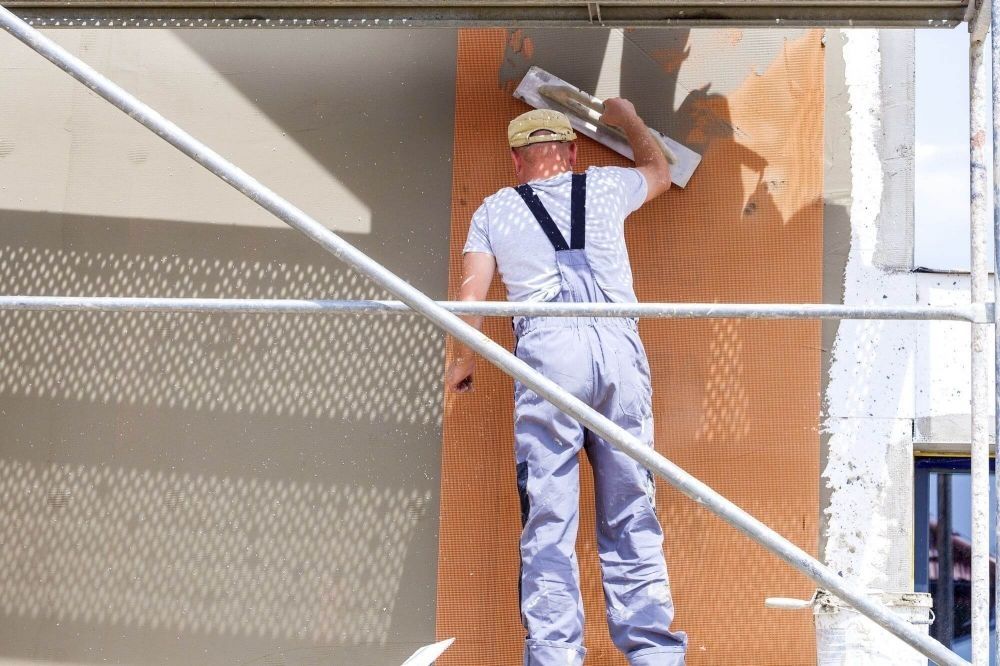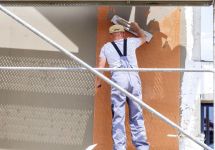Stains and discolouration on exterior plaster - how to get rid of them?
Plaster discolouration is not only a matter of aesthetics. It is the effect of serious errors made during insulation works, therefore we should not neglect them.
During wrong conditions
Each manufacturer determines what conditions a plaster can be applied. Tolerances are wide - usually from 5 to 25°C, a lack of intense and direct sunlight, strong wind and precipitation. Too fast curing, typical for the summer conditions, contributes to discolouration, caused by incorrect bonding of the plaster. Contrary to popular belief, the purpose is not to dry the plaster but its chemical curing, which requires relevant temperature, moisture and time. Thus the plaster must be protected against intense sunlight and wind.
On the other hand, low temperature below +5°C, slows down or practically prevents chemical reactions in the plaster and the point of contact with the substrate. Silicate plaster is a very good example, which is very strongly bonded to the substrate as a result of chemical reactions. Yet only when temperature and air humidity are relevant.
It’s important, during application or even several days after, to protect is against direct precipitation. Water can damage its structure and wash out pigments ensuring colour.
Negligence
Painstaking and good work organization is essential. For example, the rule should be to cover one plane (wall) with a particular colour during one work cycle. If works are interrupted and resumed the next day, it is very unlikely to avoid discolouration on the point of contact. It refers both to plastering and painting. In addition, a close attention must be paid to window and door edges. Incorrectly finished and next corrected will be certainly different.
Incorrect mixture preparation
Plaster compounds mixed with water at the construction site must be mixed in a proportions strictly defined by the manufacturer. It must be mixed carefully and the amount of water must be exactly the same when preparing other portions. Otherwise, we can forget about colour uniformity. In addition, the compound with too much water has incorrect consistency and after curing holds less strength and excess porous structure. Unsuitable colour will not be the only problem then.
Ready-to-use plaster compounds require very careful mixing with a slow-speed agitator.
Attention! Water must be clean, iron free, which is commonly found in water from drilled wells. Generally, we adopt the rule that drinking water is used for mixing with plasters. Also, tools and containers cannot come into contact with the plaster. Stainless steel and plastics are safe.
Too early plastering
White efflorescence on freshly applied plaster, commonly called “lime” one, is a typical result of applying it on not sufficiently seasoned (still wet) or dampened with rain water substrate. 3 days is absolute minimum between applying a reinforcing layer with mesh and plaster. It must be carried out in favourable weather conditions (temp. approx. 20°C). Otherwise, binders curing is disturbed and the migrating water outside (consequently to plaster) contains dissolved mineral salts. Sometimes the plaster layer on a wet substrate can even come off.
A lack of appropriate undercoat
In addition, the adhesive layer must be covered with so called undercoat, often mistakenly called a primer. This undercoat forms a layer which hampers mineral salts to penetrate the plaster from the substrate, thus makes it difficult to produce white efflorescence described above. In addition, it is available in various colours and can be matched with a subsequent plaster. The visible grey layer through the plaster can be significantly decreased.
No rush with painting
Contractors are driven by a principle - time is money - however, rush is not a good advisor during the final stage i.e. - painting.
For example, mineral plasters should be painted after minimum:
- 4 weeks - acrylic paint;
- 2 weeks - silicone paint;
- 5 days - silicate paint.
If temperature is low, the curing process slows down and this time must be extended. Too early application may result in uncontrolled chemical reaction between the plaster and the paint, contributing to discolouration. In addition, particularly acrylic paint can be subject to flaking, as water in the plaster is unable to evaporate.

